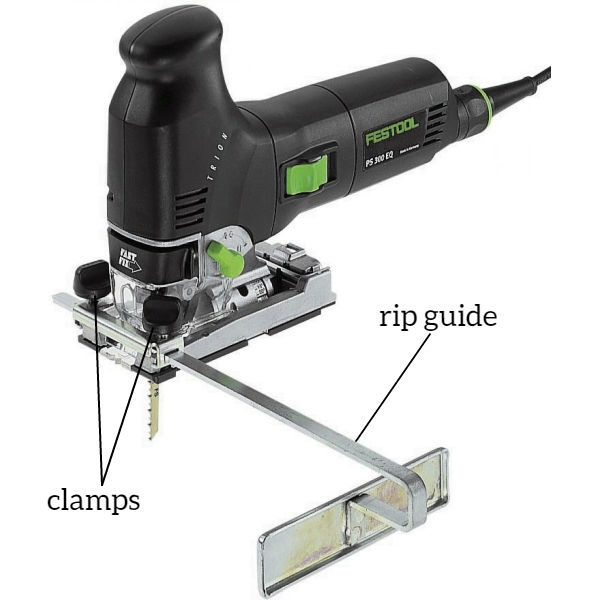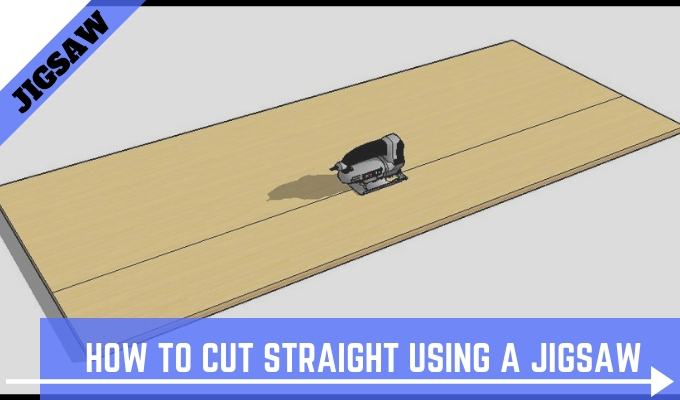
To cut a straight line with a jigsaw, all you mostly need is a good accurate cutting line and a sharp jigsaw blade to follow it. Although a jigsaw is the tool of choice for cutting curving lines, it’s no slouch at cutting a straight line, either.
TIP!
It is important to note that other tools are recommended for making straight cuts as they are more efficient and will naturally cut a straighter line (like a circular saw) but a jigsaw CAN be used if necessary.
Plus, a jigsaw can cut a straight line in a wide variety of materials, from wood and laminate to plastic, metal sheets, and even ceramic tile.
The way to use a jigsaw to cut a straight line somewhat differs depending on the straight line you need to cut.
Jigsaws are capable of making rip cuts, cross cuts, miter cuts and bevel cuts in a wide array of materials. A jigsaw is even capable of starting an accurate straight line cut from the middle of the material, if you have a need for a plunge cut.
What You Need To Cut A Straight Line With A Jigsaw...
The Essentials: First, you need a way to mark out straight, accurate cutting lines. A measuring tape and a pencil are two of the essentials for making basic rip cuts, cross cuts, and 45-degree angle miter cuts.
Next thing that you will need is your set of jigsaw blades. The thicker jigsaw blades tend to do a little bit better in wood because they have less flex to them.
Straightedge Or Guides: And lastly, a set of guides will be a huge help for ensuring that the straight cuts you do are clean and consistent every time.
Even a set of clamps and a straightedge, or even a piece of lumber will make a big difference, as long as it’s a straight fence that the jigsaw shoe can rest against as the tool makes the cut.
Blade Flex: The less your blade has a tendency to flex, the less the risk of the blade wandering from the cutting line, even if it encounters a knot in the grain of the wood.
Thicker, more rigid jigsaw blades also work well with an orbital action compatible model and will help make the process a little quicker when cutting through wood, laminate and similar materials.
Reverse Tooth Blades: If you need a better finish from the top surface of the work piece, reverse teeth jigsaw blades will cut on the downstroke to minimize tear-outs on the top of the material. Keep in mind that reverse teeth blades don’t work well with orbital action, though.
If you are working with materials other than wood, you will need to make sure you have the appropriate blade for the job keeping rigidity in mind as well.
How to Do A Cross Cut Or Shorter Straight Cut With A Jigsaw:
To do a short straight cut with a jigsaw, simply lay down a cutting line, start the jigsaw and follow it to the end. A cross cut is a cut made across the grain of the wood.
Wooden boards and lumber are usually made with the grain going lengthwise, hence most cross cuts and miter cuts you will do on them will be short straight cuts.
First, mark the measurement of the cut with a measuring tape and pencil. Then take a square and mark out the cutting line on the workpiece, making sure to make a note of the waste side of the cut.
Then trace a line with a speed square (if smaller lumber) or a framing square to get a straight line.
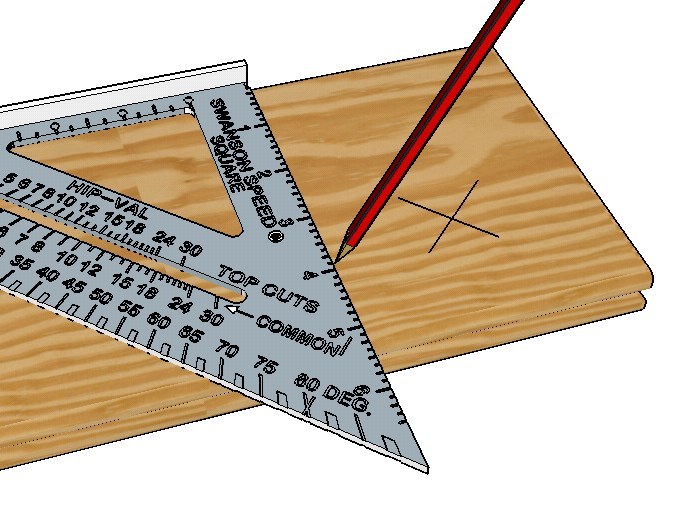
It’s a good habit to first check the jigsaw blade for straightness and alignment before making the cut. Give the blade a quick check with a square to make sure it is perfectly perpendicular with the shoe.
A blade that’s bent or out of alignment can ruin a cut if it snaps in the middle of the run. - you’re better off playing it safe with a new blade.

Position the jigsaw near the cut, with the shoe resting on the material. Turn the tool on and let it run up to speed, then steadily bring it into the work piece to start the cut.
You may also find that resting the blade on the material first before starting it can help it to grab and prevent bouncing when starting your cut.
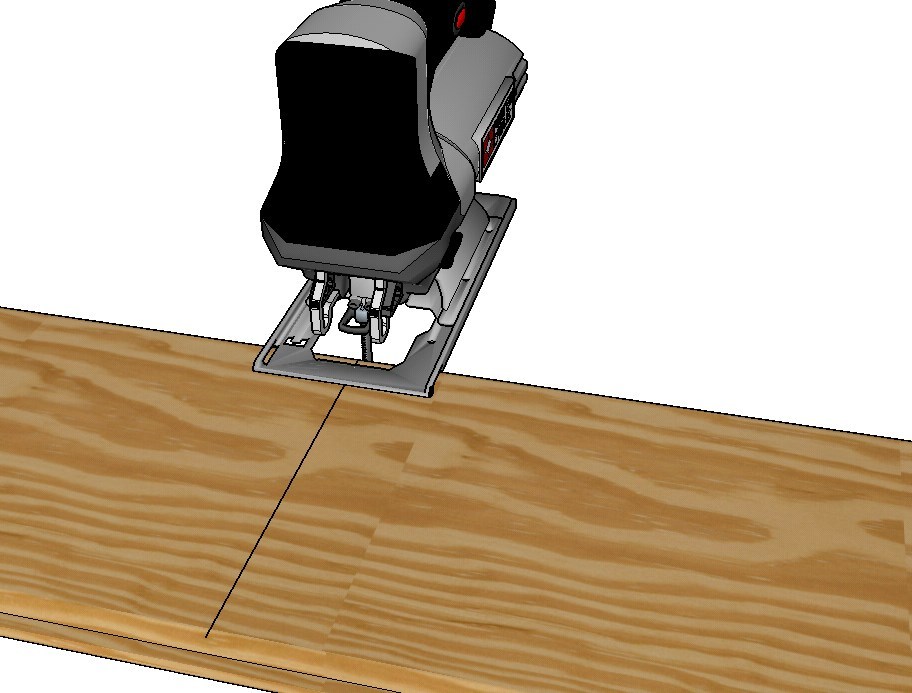
Make sure that the work piece is held tight or clamped down throughout the cut, and focus on following the cutting line until you get to the end.
How to Do A Rip Cut Or a Long Straight Cut With A Jigsaw
A rip cut is a cut done parallel to the grain of the wood. This means that for rip cuts, you’re also doing a long straight cut with the jigsaw most of the time. Long straight cuts, whether on wood, laminate, or metal sheets, are best done with a jigsaw using a fence.
To make a fence for your jigsaw, you can clamp a straightedge parallel to the cutting line of the cut you wish to make.
The shoe of the jigsaw will rest against this fence as you guide the cut, hence you will need to clamp the straightedge at a certain distance from the cutting line.
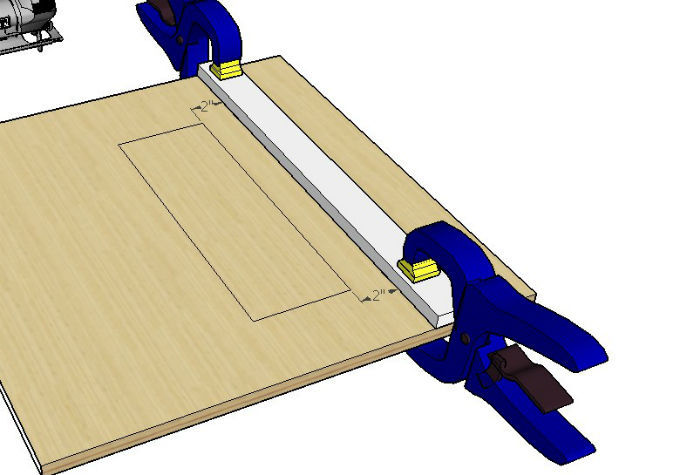
Clamp Straightedge To Workpiece On Reference Line
This distance is the offset distance between the edge of the shoe and the side of the blade.
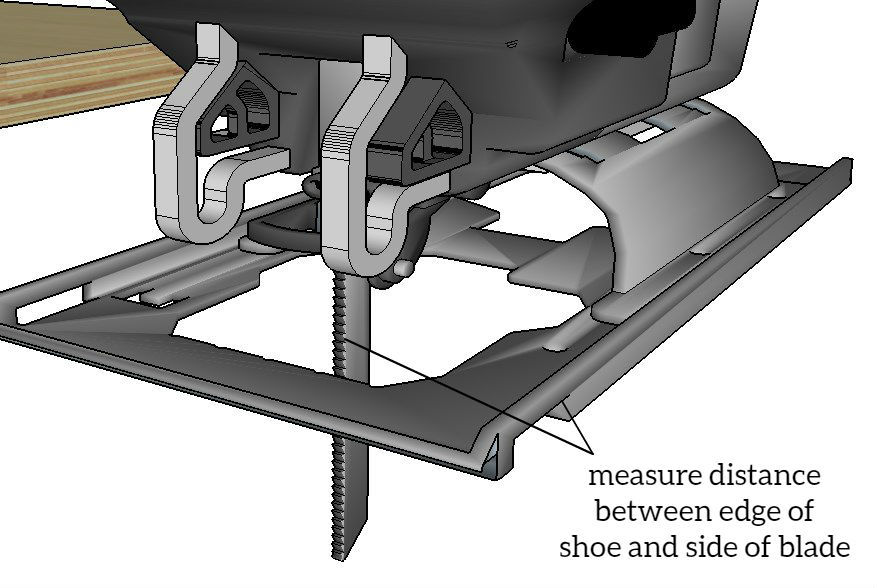
Measure Jigsaw Blade And Shoe Difference
Make sure that you have the right blade for the material and the right orbital setting (if needed) – off for reverse teeth blades, and on for ripping wood efficiently. Turn on the tool and once the blade gets up to speed, bring the blade into the material at a steady speed.
Focus on resting the shoe against the fence as you check that the blade is following the cutting line.
The jigsaw blade will do the work of cutting into the work piece efficiently without the need for you to push it hard against the material – pay closer attention to shoe against the fence, instead.

Jigsaw Lined Up With Guide
Depending on the blade you use, the type of material you are working with, and the thickness of the work piece, you will need to adjust the speed of the jigsaw to compensate for the cleanest cut possible.
For heavy work loads that consist of a lot of long cuts, you may also need to give the jigsaw a break every now and then to cool down the motor. Make sure that the blade has stopped moving completely before putting it down.
Using A Rip Guide With A Jigsaw:
Some models allow the use of a guide when ripping down longer pieces and they are very similar to ones you would use with a circular saw. In fact, they work the same way and are even fastened the same way to the jigsaw itself.
Here is an example of a simple rip guide that gets clamped onto the front of the shoe with two screws, located on the top side of the shoe.
The metal plate slides against the edge of the piece that you are working on and can be adjusted to widths from roughly 3" and up.
There are other guides that you can use with a jigsaw that manufacturers have come out with and are worth checking out.
Making Straight Cuts In Harder Materials:
It is basically the same process to cut straight lines in harder materials like tile and metal but you will usually have to use a lower speed and take a slower approach when cutting.
Some materials may also need to have water or oil added to the piece in order to keep the blade cooler during the cutting process. All of the same steps apply though when cutting straight lines in these materials and you can use guides, straightedges, etc. as well.

